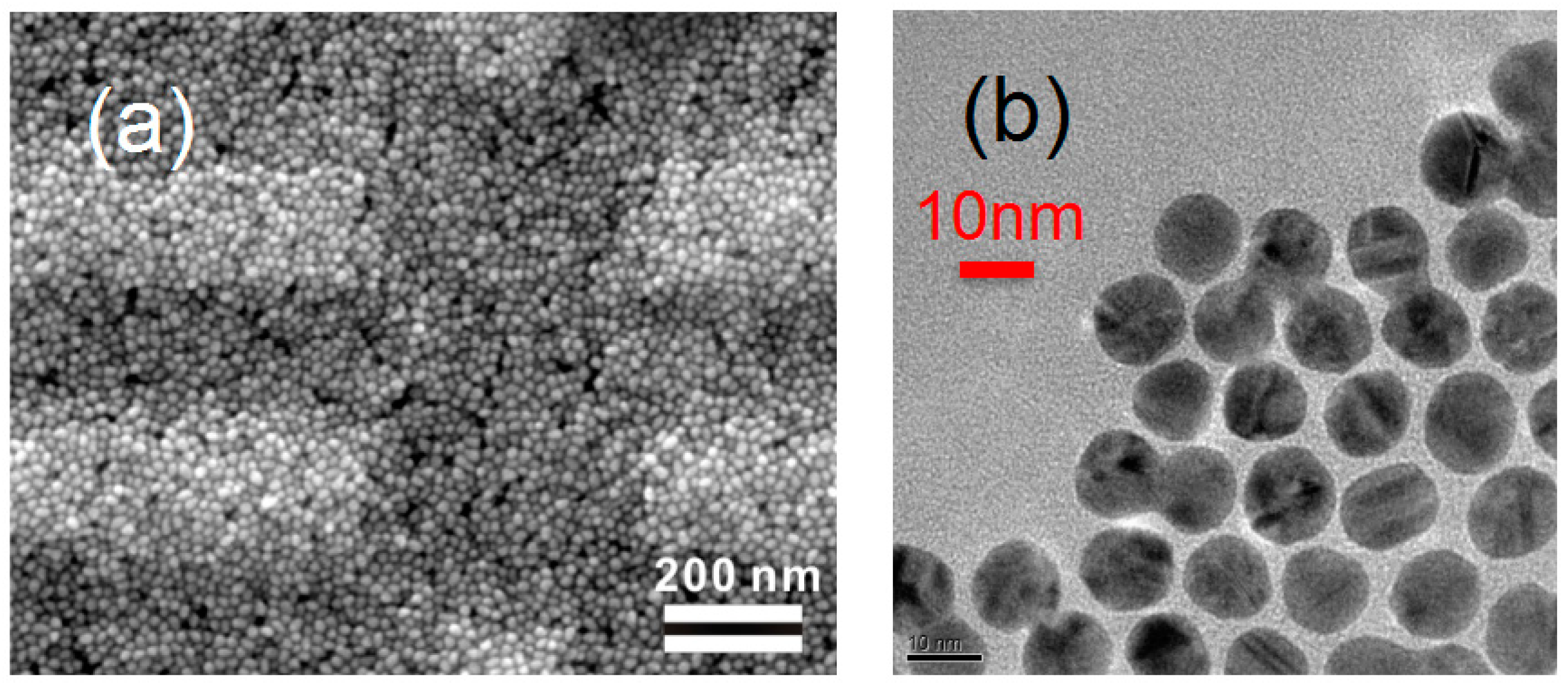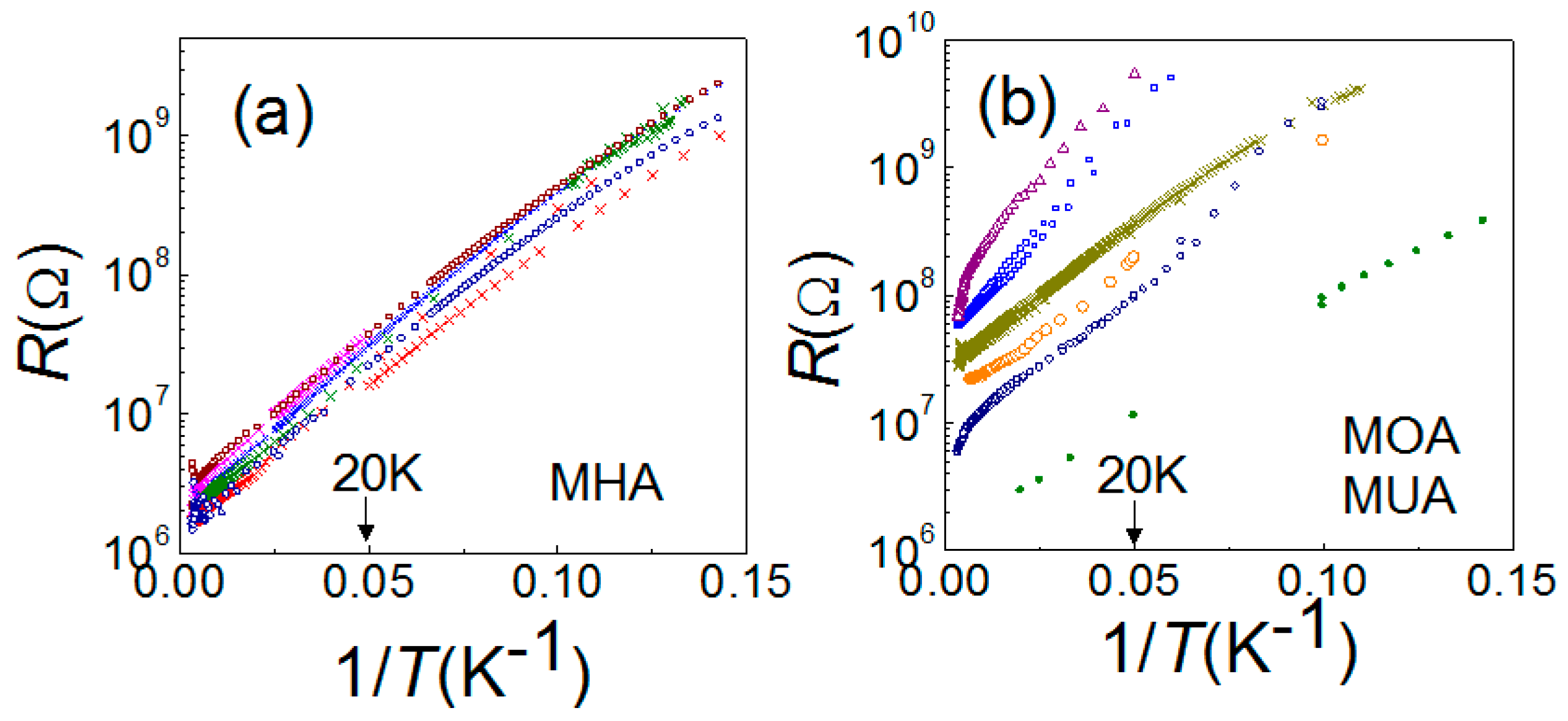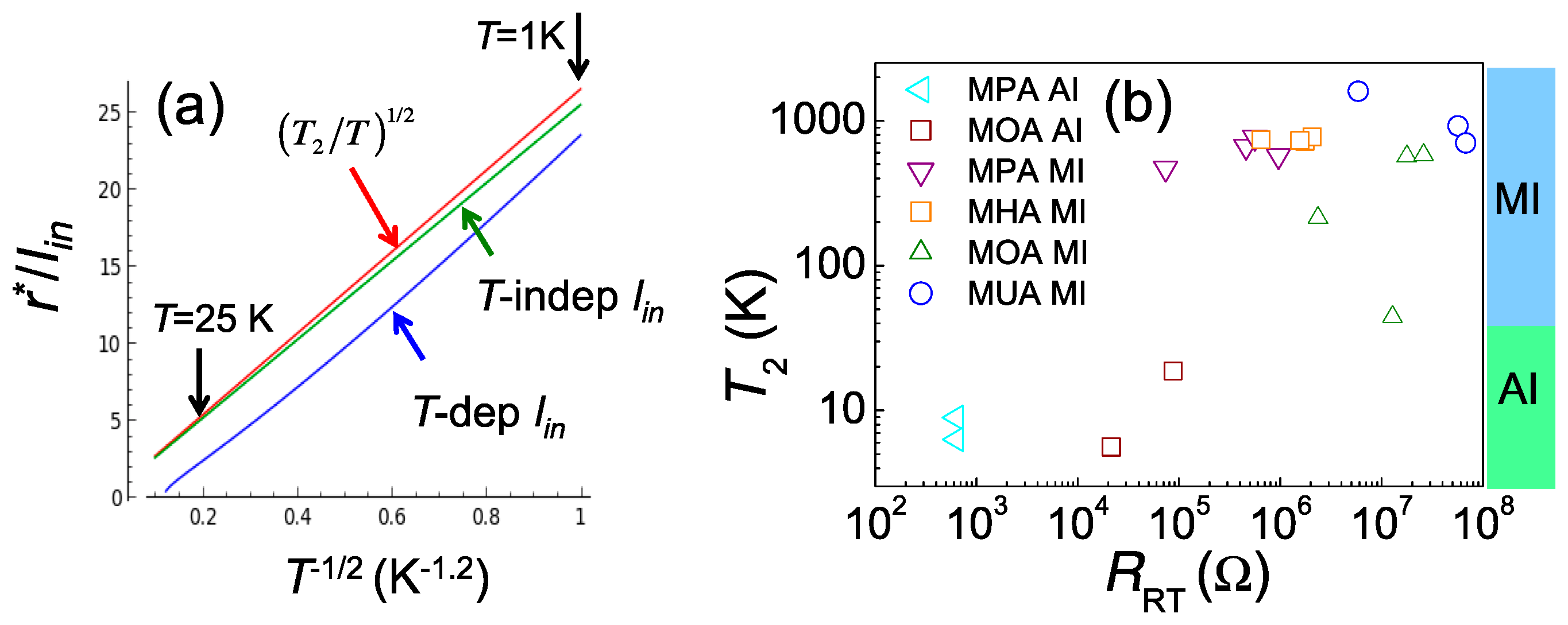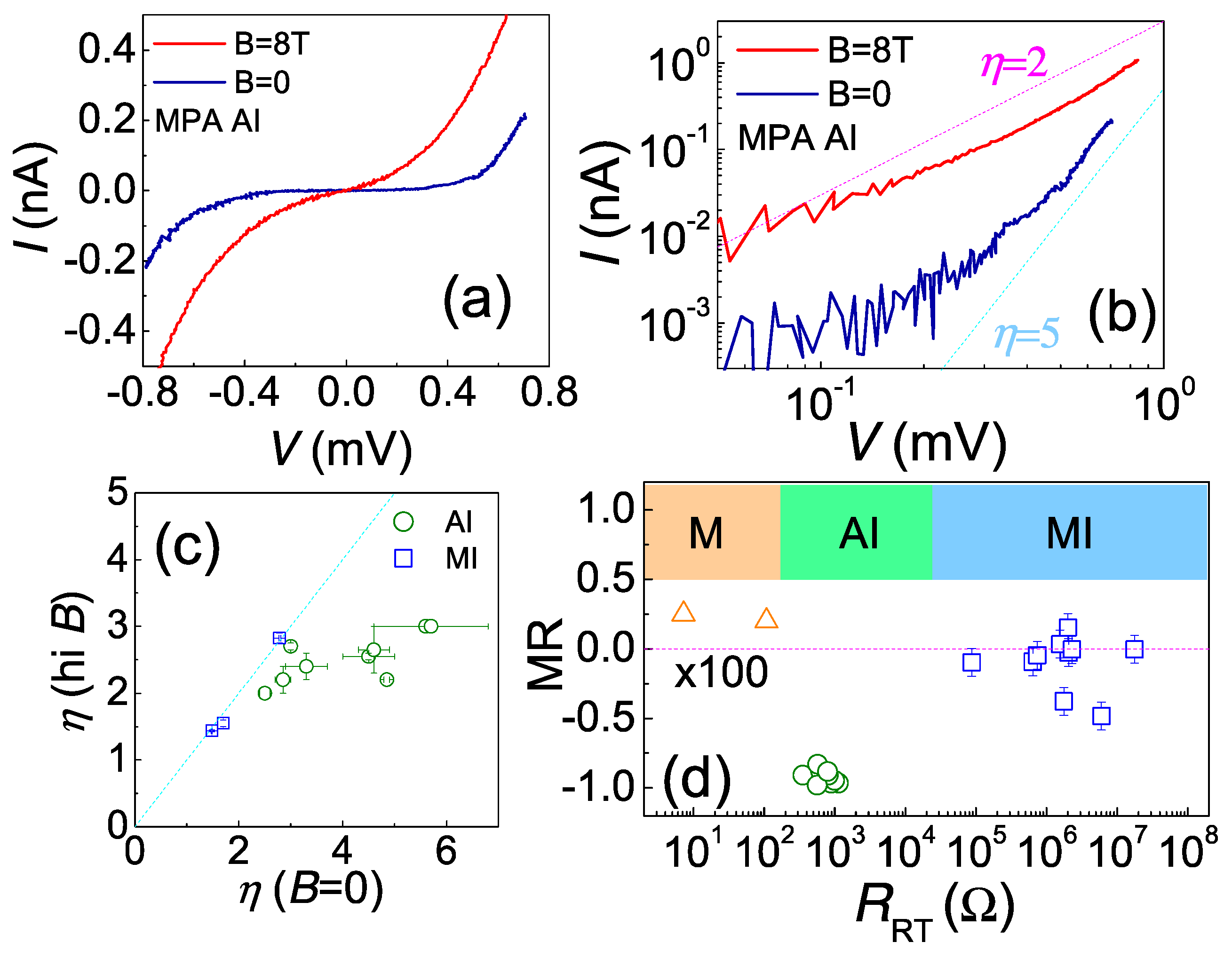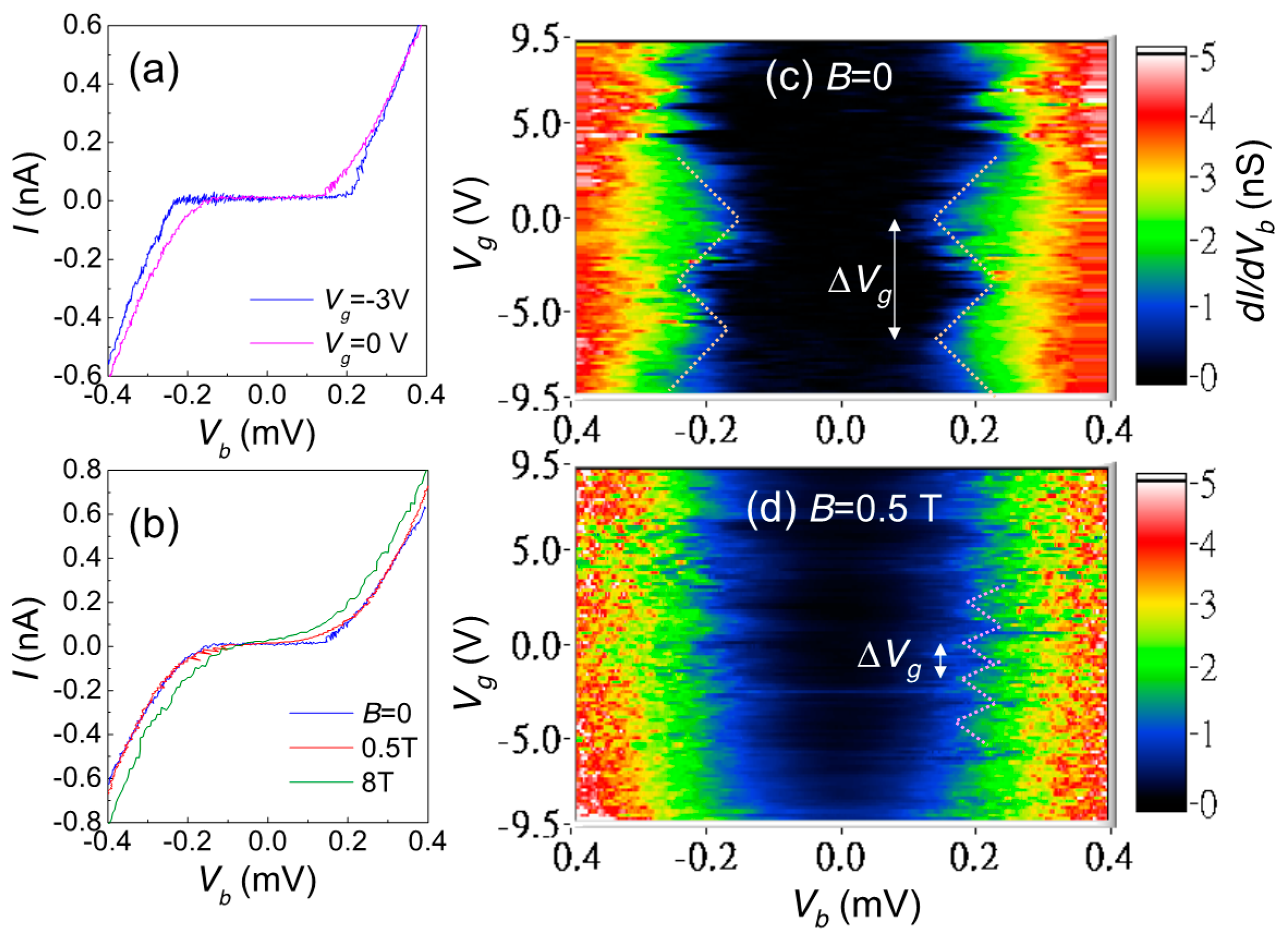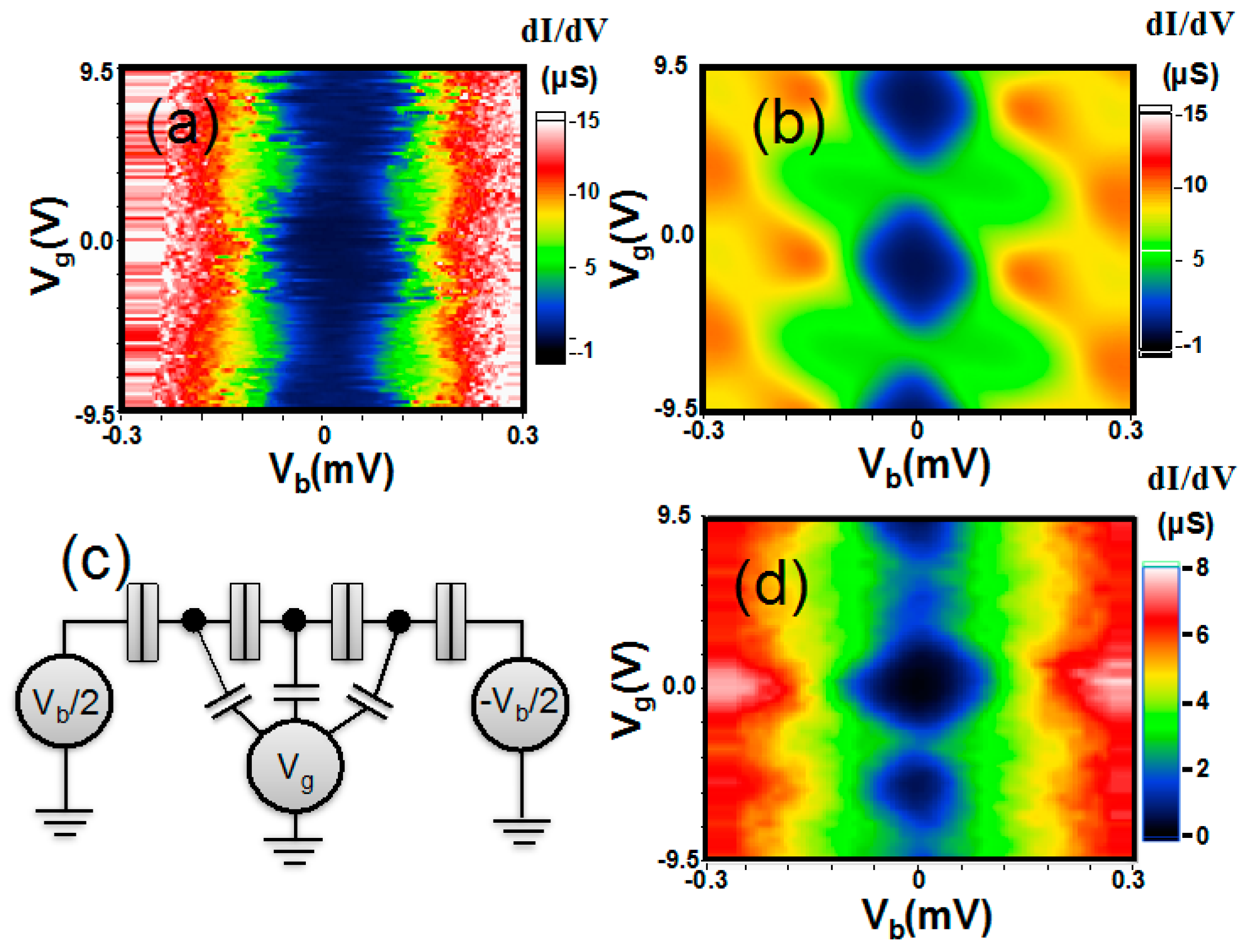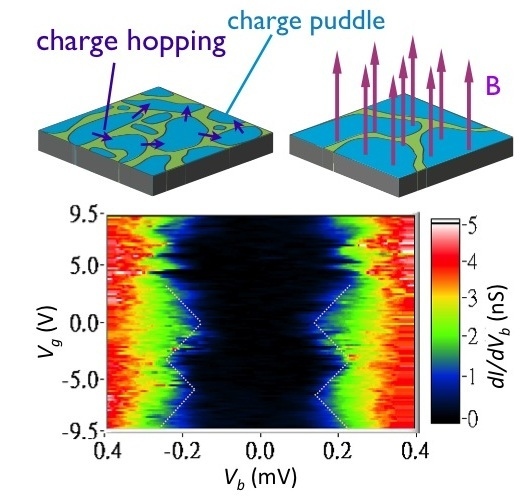2.1. Temperature Dependent Resistance
Figure 1a shows the multilayer Au NP film deposited on the substrate with premade electrodes. The gap between adjacent electrodes is 200 nm. The transmission electron microscopy image shown in
Figure 1b reveals that the synthesized Au NPs are highly uniform in size, having an average diameter of 12 nm. Great variations in resistance
R for devices with different surface modification molecules were found at room temperature. Enlisted in
Table 1, the resistances show a high correlation to the interparticle distance
s, which is estimated from
s/nm = 0.54 + 0.12
n [
27]. For most of the devices, the exponential dependence
R ~ exp (
βxs) are found, with
βx ~ 11.8 nm
−1.
The temperature-dependent resistance,
R(
T), typically provides simple criteria for judging whether a device is metallic or insulating. As one can see in
Figure 2b, a metallic behavior that the resistance increases linearly as temperature rises (
dR/
dT > 0) was found for Au NP films modified by short (MPA) carbon-chain molecules; an insulating behavior that the resistance decreased non-linearly was found for the AuNP films modified by long (MUA, MOA and MHA) carbon-chain molecules (
dR/
dT < 0). For MOA and MHA devices, a small resistance hump is found at the temperature around 235 K, which could be attributed to the contraction/expansion of residual water in the film. At low temperatures, these insulating devices exhibit non-linear current-voltage (
IV) characteristics. These behaviors briefly signify an MIT by tuning the carbon number from
n = 3 to
n = 6 (
s from 0.90 nm to 1.27 nm) [
10,
28].
Near the transition, the metallic and insulating behaviors require a closer inspection because disorder may give substantial impact. In particular, NP assemblies linked by MPA molecules may have versatile
R(
T) behaviors: although most MPA devices (referred to MPA M) are metallic that exhibit linear
IV and
dR/
dT > 0, we could find exceptions, noted by MPA AI and MPA MI devices, showing insulating behavior. As illustrated in
Figure 2c, the metallic or insulating behaviors of MPA devices are closely related to their room-temperature (RT) resistance,
RRT: A high-
RRT device tends to be insulator-like. Since the Au NP assemblies using our deposition scheme were not always closely packed and regular,
RRT for a specific molecule modification varied from sample to sample. To clarify the role of
RRT in MIT, we lowered the junction barrier height of insulating MOA devices by applying high dosage e-beam exposure. The exposure reduced the
RRT of MOA devices at most five orders of magnitude and drove some devices across the critical point of MIT at
RRT ~
RK. As one can see in
Figure 2c, e-beam exposed MOA devices may exhibit metallic (MOA M) or insulating (MOA MI) behaviors, evidently relating to their
RRT. In addition to the interparticle coupling strength, the disorder, which is hardly determined by
RRT, serves as another parameter governing the MIT in these NP assemblies.
2.2. Mott Insulator and Cotunneling in Molecule Junctions
According to the theoretical prediction for MIs, the charge transport should follow the thermal activation law, Equation (3). It is easy to test the validity by plotting the device resistance
R as a function of 1/
T for insulating devices. As shown in
Figure 3, MHA, MOA and MUA devices satisfy such a law when
T > 20 K. The slope of this plot gives the characteristic temperature
T1, a measure of Hubbard gap. Summarized in
Table 1,
T1 falls in the range between 40 and 80 K, except some devices with
RRT <
RK. As we have mentioned, it is plausible to assume that
RRT is a good estimation of tunneling resistance in the theoretical model. Consequently, the insulating devices with
RRT >
RK receive negligible charge fluctuation so
T1 ~
EC/
kB, which is similar in our devices with the same NP size. According to Abeles formula,
EC/
kB ranges from 50 K to 75 K depending on the value of interparticle distance
s. In contrast, the devices with
RRT close to
RK would have a much smaller
T1, typically smaller than 10 K, because of the quantum correction. In an earlier work, we already presented how
T1 depends on the tunneling resistance and found a good agreement with Equation (2) [
19].
At lower temperatures, the disorder may result in the charge cotunneling in the molecule junctions, producing a transport resembling the E–S VRH. Before analyzing our data that is mostly measured at
T > 2 K, we first judge that they are better explained by the inelastic channel, based on the fact that the elastic-inelastic crossover temperature
~ 2 K with the level spacing
~ 0.1 meV and
E/
kB(~
T1) = 50 K. Moreover, we should look if E-S VRH law is well obeyed with a temperature-dependent
lin. Calculation on the hopping exponent (
r*/
lin) was performed by using parameters obtained in our experiments:
a = 12 nm,
g = 0.01,
E/
kB(~
T1) = 50 K,
κ = 21.5. The blue curve in
Figure 4a shows temperature-dependent
lin using Equation (10), while the green curve shows temperature-independent
lin = 0.1
a. As a comparison, the function (
r*/
lin) = (
T2/
T)
1/2 with
T2 = 700 K is plotted with the red curve. Indeed, Equation (10) describes a slowly varying function of
T, so the blue curve is highly linear in the temperature regime from 25 K to 1 K. In addition, all curves show similar slopes in this plot.
Figure 4b illustrates a summary of
T2 values for insulating devices. One could see that
T2 ~ 1000 K for devices with
RRT >
RK. As discussed in the previous section, a large
RRT guarantees a weakly coupled NP network and a standard MI. As such, the cotunneling length
lin ~
a according to Equation (10). An effective dielectric constant
κ ~ 20 is much larger than that of the insulating matrix molecules
κm, owing to the charge screening effect from mobile charges within nearby NPs.
Devices having a lower RRT follow the E–S VRH law but with a much lower T2 value. The unusual low T2 could result from a huge κ and/or a very large lin. The later seems unreasonable in the scope of charge tunneling in weakly coupled NPs; however, these low T2 systems are on the threshold of strong coupling, so a new picture beyond inter-NP charge hopping is needed. If κ is unchanged, the cotunneling length is increased by two orders of magnitude, inferring the charge delocalized from a single NP but confined in a larger space lin ~ 10–100 a. Such a confinement can be argued to originate from Anderson localization due to quantum interference. To confirm this, one should investigate the magnetic response of these devices.
2.3. Magnetoresistance
It is beneficial to examine the magnetic response of the charge transport in metallic devices in the beginning.
Figure 5a,b respectively illustrate the magnetoresistance (MR) of an MPA metal in the parallel field at
T ~ 100 mK and a MOA metal in the perpendicular field at
T = 2 K. Both cases show a positive MR saturated at a field about
B ~ 3 T, and can be explained by the weak anti-localization. Owing to the strong spin-orbit interaction, weak anti-localization is commonly observed in metals with large atomic weight, such as Ag and Au. In NP assemblies, the electron may be scattered by the defects inside the NP (bulk scattering) and the molecule junctions. For metallic devices, NPs are strongly coupled and the electron wave function may extend across large numbers of NPs so the bulk scattering with large spin-orbit interaction is dominant.
The theory of weak anti-localization asserts the conductivity change in a magnetic field perpendicular (
) or parallel (
) to the film as [
29]:
in which
t is the film thickness,
is the magnetic length, while
le and
lφ are elastic and inelastic scattering lengths.
is the digamma function.
Figure 5a also presents the fitting result according to Equation (12) by using
t = 30 nm, and a sheet resistivity of about 12 Ω. The characteristic length
~ 300 nm, which gives a minimal inelastic scattering
lφ ~ 9 µm if one accounts for the upper bound of
le ~ 2
r = 12 nm. In contrast, the fitting result for
Figure 5b gives a characteristic length
~ 100 nm. The reduction of
le and
lφ for the latter case is probably due to the electron–photon scattering at a higher temperature. Nevertheless, the MR indicates a large
lφ and vigorous quantum inference for conduction electrons at
T < 1 K.
Insulating devices may exhibit two distinct MR behaviors, which are closely related to their
T2 and
RRT. Devices having large
T2 values are virtually not affected by the magnetic field. In contrast, extraordinary magnetic field responses were observed in devices having low
T2 values (typical < 10 K).
Figure 6a illustrates the
IV characteristic of a low
T2 MPA device at
B = 0 and
B = 8 T at
T ~ 50 mK. In both cases, the
IV presents sub-meV gap, of which the size clearly shrinks in the large field. When
V > 0.05 mV, the non-linear
IV curves follow a power law,
as shown in
Figure 6b. At zero field, the
IV exponent
η is ~5, while it reduces to ~2 in a large magnetic field. The quantitative change in
IV curves for some insulators is best illustrated in
Figure 6c, in which we summarize how the
IV exponent
η changes with the field. It is found that
η can be reduced by one-half at most. A power law in
IV curve is predicted by the cotunneling theory for weakly coupled NPs, and the exponent
, where
j is the number of junctions involved in the cotunneling process [
30]. However, such a picture needs correction before applied to AIs, since the localization length for cotunneling may be very large,
lin >>
a.
Our non-magnetic devices should not present significant magnetic response unless the charge transport is strongly affected by quantum interference, which can be easily destroyed when a magnetic field is applied. Despite the positive MR in metals, we always find a negative MR for insulators, inferring that the charges are delocalized by the magnetic field. Therefore, it clearly shows that the charge gap strongly relies on the presence of quantum interference, following the description of Anderson localization. As such, these devices are considered as Anderson insulators. Additional evidence is the reduction of η, which relates to the numbers of junction involving in cotunneling in a large field. Two possibilities may result in this: the magnetic field weakens the charge–charge interaction, effectively reducing the most probable hopping range r*, or the field simply enlarges the inter-junction distance. For the former one, η for all kinds of insulator should be changed, which is not true for MIs. The later one is meaningful only for AIs, in which “inter-junction” distance is the size of charge puddles, not of NPs.
Figure 6d presents a summary of MR values measured at low temperatures (for MIs at
T > 2 K and for others at
T < 100 mK) in comparison to their RT resistances,
RRT. Again, we can see a good correlation between MR and
RRT: when
RRT is smaller than ~100 Ω, the device presents a small positive MR, typical at the order of 0.2%, featuring the weak anti-localization in a disordered metal. When
RRT is greater than ~10
5 Ω, we see very small MR except for two special cases. When
RRT is in between, the device would present large negative MR. In most cases, the resistance can be reduced for one to two orders of magnitude at
B = 8 T. This infers that the magnetic response is a good indication for telling the difference between an MI and an AI.
Here, we would like to comment on the important length scales for AIs, which is schematically illustrated in
Figure 7. The localization length of AIs should not be larger than the electron inelastic scattering length and the magnetic length and has to be larger than the NP size. Therefore, we could set criteria for observing AIs in NP assemblies, min (
lφ,
lH) > 2
r. To meet the criteria in our case, low temperature and low magnetic field—
B ~ 0.1 T are essential. As the magnetic field increases, the charge puddles should be gradually enlarged, and an external gate voltage can be employed to probe the size change. We will discuss the gate-voltage modulation in the following section.
2.4. Single Electron Tunneling and Gate-Modulated Transport
At mK temperatures, MPA AIs present significant gate-modulated transport with the application of back-gate voltage. Because the Si substrate becomes insulating at low temperatures, the conducting gate electrode is ~ 0.5 mm far below the Au NP film. With such a distance, the current change is perceptible when applying a large gate voltage on ~1 V scale.
Figure 8a shows
IVb characteristics at
Vg = 0 and −3 V. Here,
Vb and
Vg respectively denote the source–drain bias voltage and gate voltage. When
Vg = −3 V, the threshold voltage for charge conduction ~0.22 mV, and when
Vg = 0 V, the threshold voltage decreases maximally by ~0.1 mV. Although the magnetic field also reduces the Coulomb gap, here the gate modulation is much smaller than the magnetic change. One can see this by comparing
IVb characteristics in zero field,
B = 0.5 T and
B = 8 T, as illustrated in
Figure 8b. When the field is small,
B = 0.5 T, the Coulomb gap is almost unchanged, but as we will see later, such a small field already alters the gate modulation into a very different pattern from that at zero fields.
The gate modulation at low fields may display the pattern of a single electron transistor (SET).
Figure 8c shows the dynamical conductance,
dI/
dVb as a function of
Vb and
Vg for such a typical device. Guided by the dot lines, we clearly see a regular modulation of the threshold voltage by
Vg with a period of Δ
Vg ~ 6.5 V, presenting the signature of “Coulomb diamond”. In addition to the main structure, modulations with a smaller period are also seen, though the period is not clear to estimate. In a small field 0.5 T, the gate modulation changes to a very different pattern as shown in
Figure 8d: both the gate-modulated threshold voltage and the period shrinks in the small field. We note that, when the field is increased to ~0.6 T, no gate modulation could be observed.
The single electron transport sensitive to magnetic fields is usually related to spin-dependent transport, such as those observed in ferromagnetic SETs. However, spin-dependent transport cannot explain the transport in our non-magnetic devices. The only possible explanation is that the SET geometry, such as size, shape or tunnel junctions are field-dependent. Indeed, the period of gate modulation reduces from ΔVg = 6.5 V to 1.0 V, giving an increase of gate capacitance from Cg = e/ΔVg = 25 zF to 100 zF when the field rises to 0.5 T. At the same time, the gate modulated threshold voltage also reduces from ~0.1 mV to ~0.05 mV, suggesting that the single island charging energy is halved and the island capacitance is enlarged from C = e2/2EC ~ 0.8 fF to 1.6 fF. Apparently, both increments of C and Cg provide strong evidence of an enlarged SET island in the application of magnetic fields. In particular, the vanishing of gate modulation suggests that the SET island may be destroyed in large fields.
As we know that when the electronic system is in a low electron concentration and there is notable disorder, the charge is localized to form charge puddles. It is very likely that the SET signature arises from the single electron hopping between charge puddles. If there is accidentally only one charge puddle inside the gap between the source and drain electrodes, we may see the single electron hopping to-and-fro between the source/drain leads and the puddle. The electric potential of the puddle is altered by the gate voltage so standard and single period Coulomb diamonds can be observed. Unlike the island of an ordinary SET, which is made of a conductor, the charge puddle is not rigid and could be deformed under the influence of electromagnetic fields. In particular, the magnetic field breaks the time-reversal symmetry required for Anderson localization. As the field increases, charge puddles may merge into bigger ones and eventually grow into a very large, single one. Then, the system comes to a situation that inter-puddle hopping disappears and gate modulation becomes difficult to observe. Moreover, because the quantum interference is completely suppressed when lH < 2r, the field-sensitive gate-modulation cannot exist in a field higher than this limit.
To understand the single-electron tunneling phenomena demonstrated by the MPA AI devices, we performed current calculations based on solving master equations for charge states of metallic islands [
31]. Prior to the calculation, important parameters were estimated from the size of the Coulomb diamond as shown in
Figure 9a, which shows a uniform gate modulation period. As a first trial, we assumed a (single-island) SET circuit, and fine-tuned circuit parameters according to experimental
IVb curves. The best
dI/
dVb-plot we could get is presented in
Figure 9b, in which the junction parameters are
CJ1 +
CJ2 = 1.4 fF,
RJ1 +
RJ2 = 100 kΩ, and
CJ1/
CJ2 =
RJ2/
RJ1 = 1.2. However, the calculation result would give a zero-threshold condition at
Vg =
e/2
Cg, against the experimental observations. Then, the multi-island circuits were assumed in further trials. By using a series combination of three islands presented in
Figure 9c and identical junction parameters,
CJ = 1.0 fF,
RJ = 25 kΩ, identical island-to-ground capacitance
Cg = 25 zF, and randomly distributed charge offsets, 0.2
e, −0.2
e and 0
e, we could obtain a
dI/
dVb-plot as illustrated in
Figure 9d. This multi-island circuit could more reasonably explain the structure observed in
Figure 9a.
In addition to the SET-like charge transport, staircase-like
IVb characteristics as illustrated in
Figure 10a were observed in some MPA AI devices when
Vg was largely biased. Such staircase structures would result in resonance-like peaks in the dynamical conductance
dI/
dVb curve as in
Figure 10b Again, we found that these resonance peaks become smeared as the magnetic field is elevated up to 0.5 T. When
B > 0.6 T, the resonance peak and gate modulation disappear, together with the shrinkage of the Coulomb gap. The magnetic field destroying gate modulation is roughly the same as that for the SET-like devices, suggesting that they have the same origin.
Staircase-like
IVb curves may have two possible origins: Coulomb staircase in a SET with asymmetric tunnel junctions, and the resonant tunneling in a quantum dot. The dynamical conductance as a function of
Vb and
Vg illustrated in
Figure 10c is essential for the understanding of the underlying physics. To elucidate the origin, we calculated the device current based on an asymmetric SET circuit. By carefully choosing the model parameters, we may obtain some calculated
IVb curve highly agreeing with the experimental data at a few
Vg values, but the calculated
dI/
dVb-plot shows structures of slanted Coulomb diamonds, a clear disagreement to the data shown in
Figure 10c, where the resonance peaks move in two different directions that form symmetric diamonds. Therefore, the resonant tunneling likely explains the observed phenomenon. The discrete quantum levels may originate from the ultra low charge density and large wavelength comparable to the puddle size.
